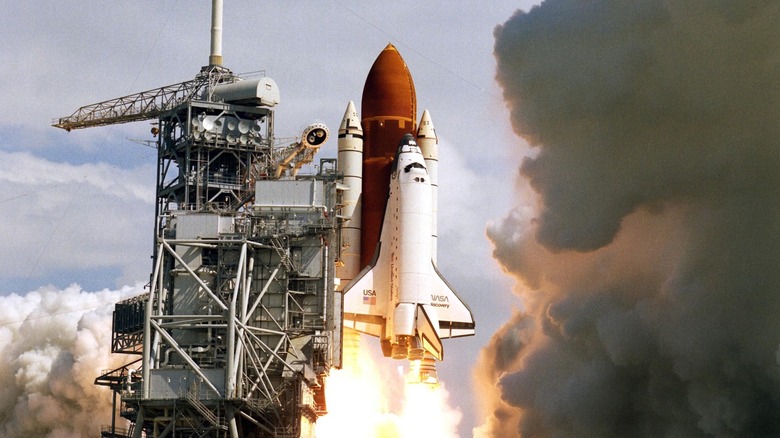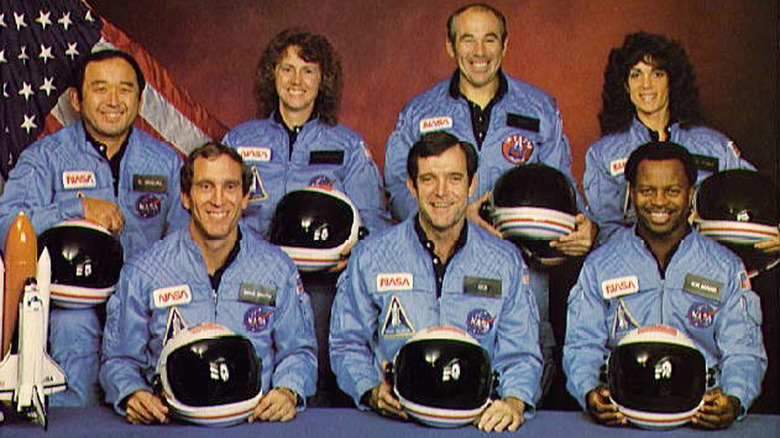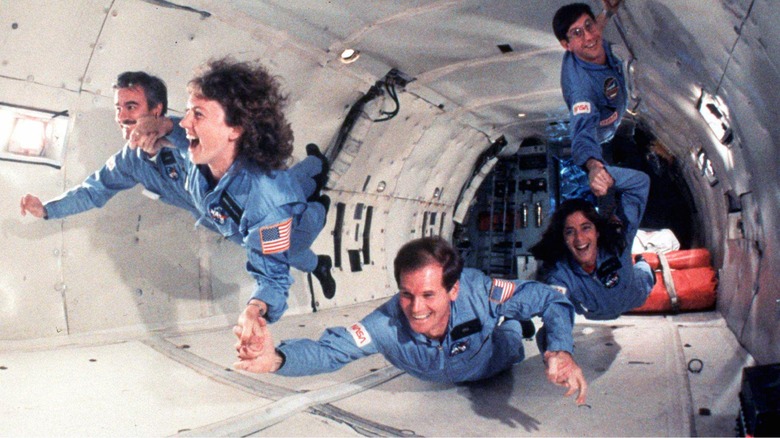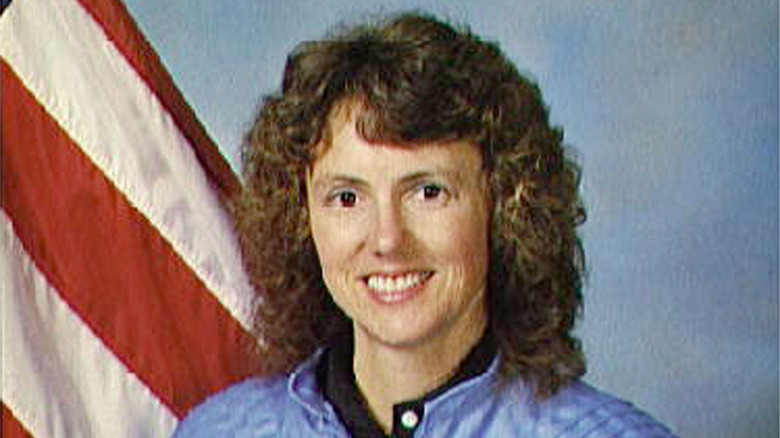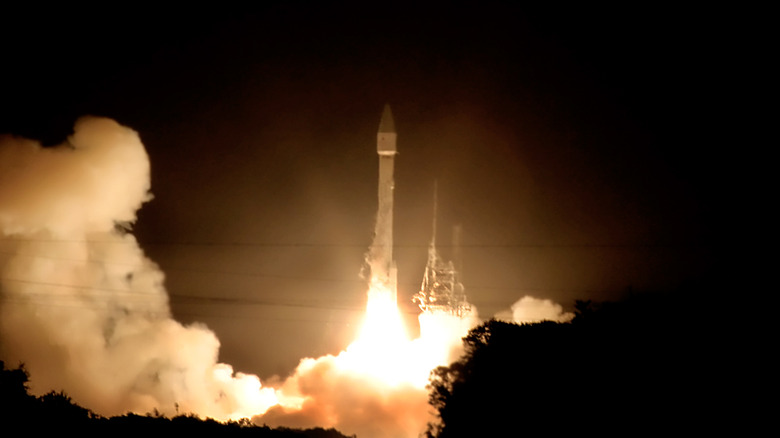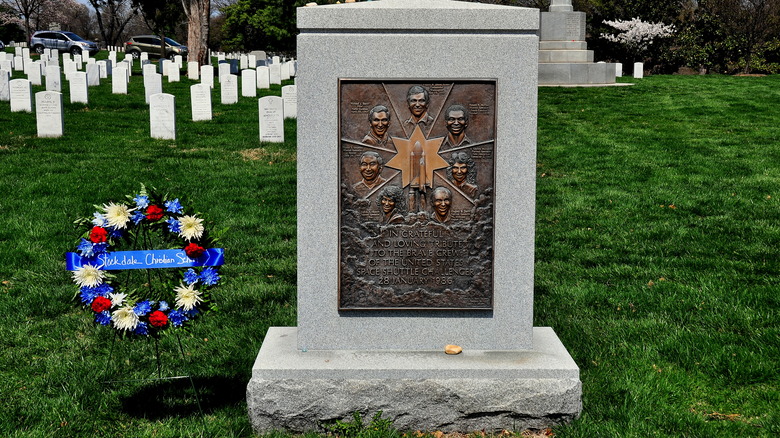Why The Challenger Disaster Had Conspiracy Theorists Buzzing
Space travel was a huge deal in the 1980s, back when everything was far out. Of course, the swirling cosmos, the draw of the unknown, and the intrigue of possibly finding life on other planets played huge roles in the craze; but there was something else too, something bigger — a sentiment that brought the concept of space travel back down to Earth. Ironically, this something else was not an extraterrestrial lifeform or even a team of extremely skilled astronauts, but just the opposite.
Smithsonian Magazine reports that the '80s was an era NASA sparked the idea of sending everyday people into outer space. The thought behind this premise was that astronauts would shoot to the moon alongside more relatable individuals like teachers, journalists, artists, and entertainers. The public would respond in kind as they watched people who led lives adjacent to their own go on epic adventures to the moon and Mars. With that end goal in mind, the Challenger shuttle was launched into space with a team consisting of several astronauts and one high school social studies teacher, who would have been the first civilian to enter space if things went according to plan (via History). However, tragedy struck almost immediately. Millions of people watched in terror as the Challenger exploded a mere 73 seconds after liftoff. School children, teachers, workers, and space enthusiasts couldn't believe their eyes when the entire crew died on national television. Some still don't believe it.
Conspiracy theorists attempted to prove the Challenger disaster was a hoax
You might have heard the many conspiracy theories centered on the moon landing, the most famous one being that the whole thing was a hoax (per Rolling Stone). According to PolitiFact, a group of skeptics has made the same claim about the Challenger disaster, suggesting that NASA pulled off a massive con, breaking the collective hearts of millions of Americans for solely the sake of cruelty.
Oddly enough, this debunked conspiracy theory doesn't aim to disprove the entire mission or even present any real evidence or suggest any malicious motives on behalf of the space tech giant. Rather, it relies on just photographs of other people who somewhat resemble the Challenger's deceased crew members (via Snopes). Perhaps the existence of such doppelgangers might have swayed a few people's opinions, but even the look-alikes are shady. Many of them are related to the astronauts that died in the launch. Here's a look.
Theorists pointed out that there are people who look like the former crew
Many conspiracy theories thrive on moving parts. They point out tiny details you might not have noticed, like the way the wind moved (or didn't, as in the case of the moon landing conspiracy) or the absence of a locality on all existing maps and websites (see Area 51). However, this theory differs slightly from the usual conspiracy in that it doesn't point out fine detail, or any details at all for that matter.
According to Snopes, the entire theory is centered on the fact that some people in the world slightly resemble the heralded astronauts who died on that ill-fated day back in 1986 (via Britannica). The theory also seems to hinge on the fact that these people are roughly the same age as flight members would be if they had survived, and they also have the same and/ or similar names. If this doesn't sound all too convincing, wait until you find out some of the people the conspirators called into question are actually the deceased crew members' siblings.
The origins of the conspiracy theory are pretty bizarre
According to Snopes, this whole theory was concocted, or at least popularized, in 2015, a full three decades after the Challenger launched into a fiery explosion. It seemingly began when a social media user noticed that Richard Scobee, a CEO in his mid-70s, bore a prominent resemblance to Francis Richard Scobee, award-winning Air Force pilot and noted spacecraft commander who lost his life in the Challenger disaster (via NASA). Adherents to the theory pointed out some similar physical attributes between this CEO and the late astronaut, such as a distinct downward sloping of the eyes contrasted by a high forehead and complementary thin-lipped grin. Combining this with the fact that both names include Richard Scobee and the CEO is roughly the age the astronaut would be if he had survived the flight, and viola — a theory with enough holes to literally launch a rocket through it (per PolitiFact).
Historians were quick to note that Richard Scobee the CEO was also alive and well in 1986 and holding down a rather demanding Chicago-based career at the time, serving as CEO and president of a popular marketing agency. You would think this fact would put the conspiracy theory to rest once and for all, but alas, it only motivated theorists to dig up more photographs of more people with similar names.
Theorists fumbled to find other doppelgangers and settled for siblings
The conspiracy theory really loses ground once theorists become so desperate for doppelgangers that they start pointing fingers at people who either look nothing at all like the former crew or people that are their blood relatives (via Snopes). Examples of the latter emerged when they turned their attention to Claude Onizuka and Carl McNair. Both of these individuals closely resemble former crew members. McNair bares a similar facial structure, knowing eyes, and lines extending around the mustache as late Challenger Mission specialist Ronald McNair. They also share the same last name. This could come across as rather mysterious until you realize they are brothers. For obvious reasons, you might expect the theory to end here; however, it does not. Instead, conspirators go on to point out the fact that Claude Onizuka also bares a striking resemblance to his late brother, Challenger mission specialist Ellison Onizuka.
Oddly enough, none of the proponents of this theory took the time to account for the long-lived lives of these siblings. For their position to hold, they would need to prove that the siblings didn't exist and were invented as alternate identities, which would be impossible given the facts. Hawaii News Now reports that Claude Onizuka was not only alive at the time of the Challenger disaster but was also present in Orlando with a group of other witnesses who stood in collective horror when the explosion took place.
Sadly, the Challenger crew might not have died immediately
In conclusion, this conspiracy theory is about as vacuous as a black hole drifting through space. Not only does it not account for the lives of blood siblings and doppelgangers, but it also fails to present any real evidence aside from speculation. Furthermore, it belittles the lives and legacies of the Challenger astronauts, many of whom fought to be the first of their people to navigate space. If the flight had not ended in horror, Sharon Christa McAuliffe would have been the first teacher in space (via Challenger Middle School), Ellison Onizuka would have been the first Japanese-American astronaut, and Ronald McNair would have been the second African American astronaut in orbit (per Snopes).
While it is clear — due to evidence and lack thereof — that the Challenger disaster did, indeed, take place, there is some speculation regarding whether or not the crew members died immediately. In 1986, the Los Angeles Times reported that activated emergency air packs were uncovered amid the wreckage, and a haunting "uh-oh" was heard uttered from the ship mere seconds before the earth-shattering explosion.
